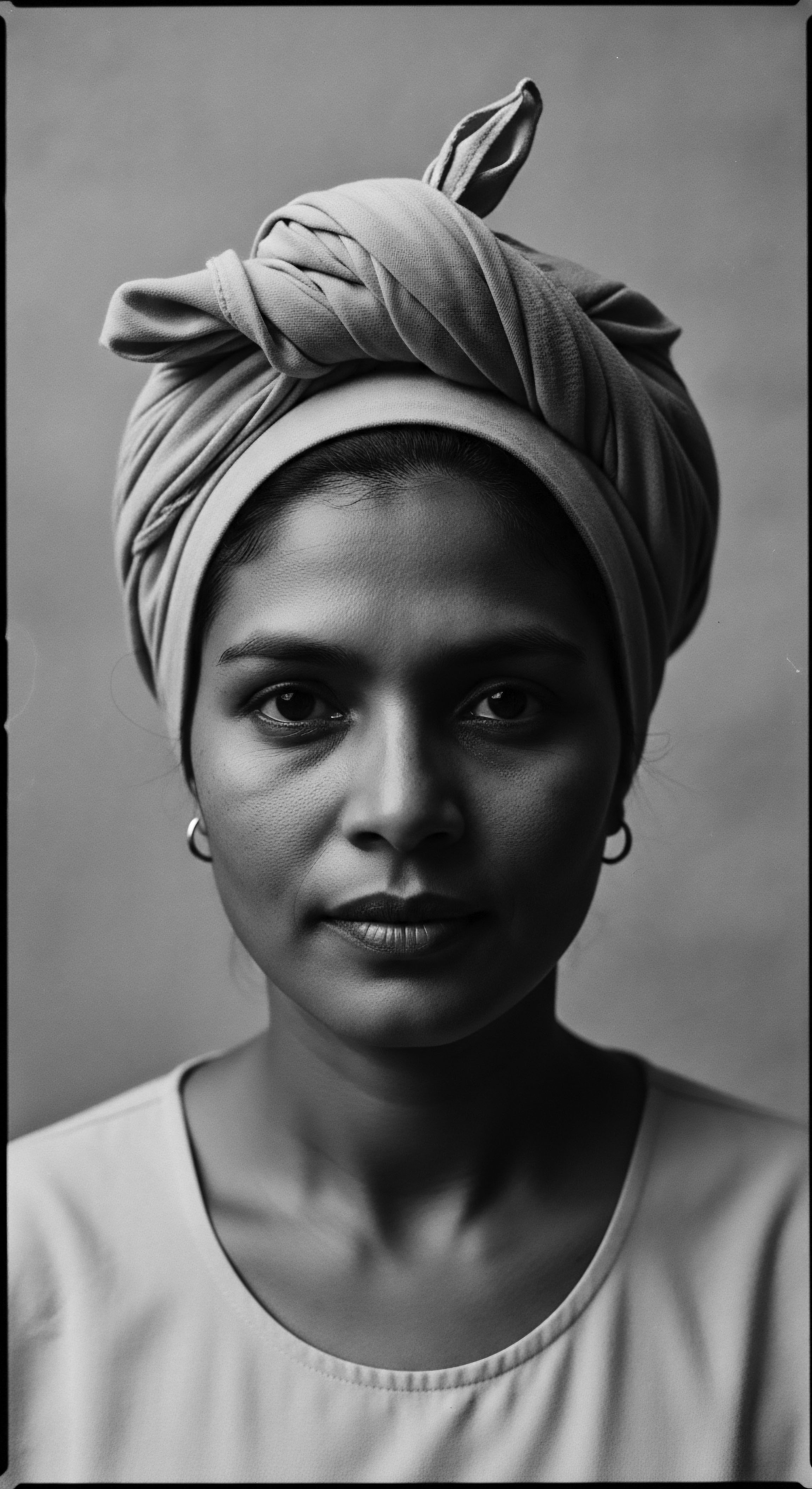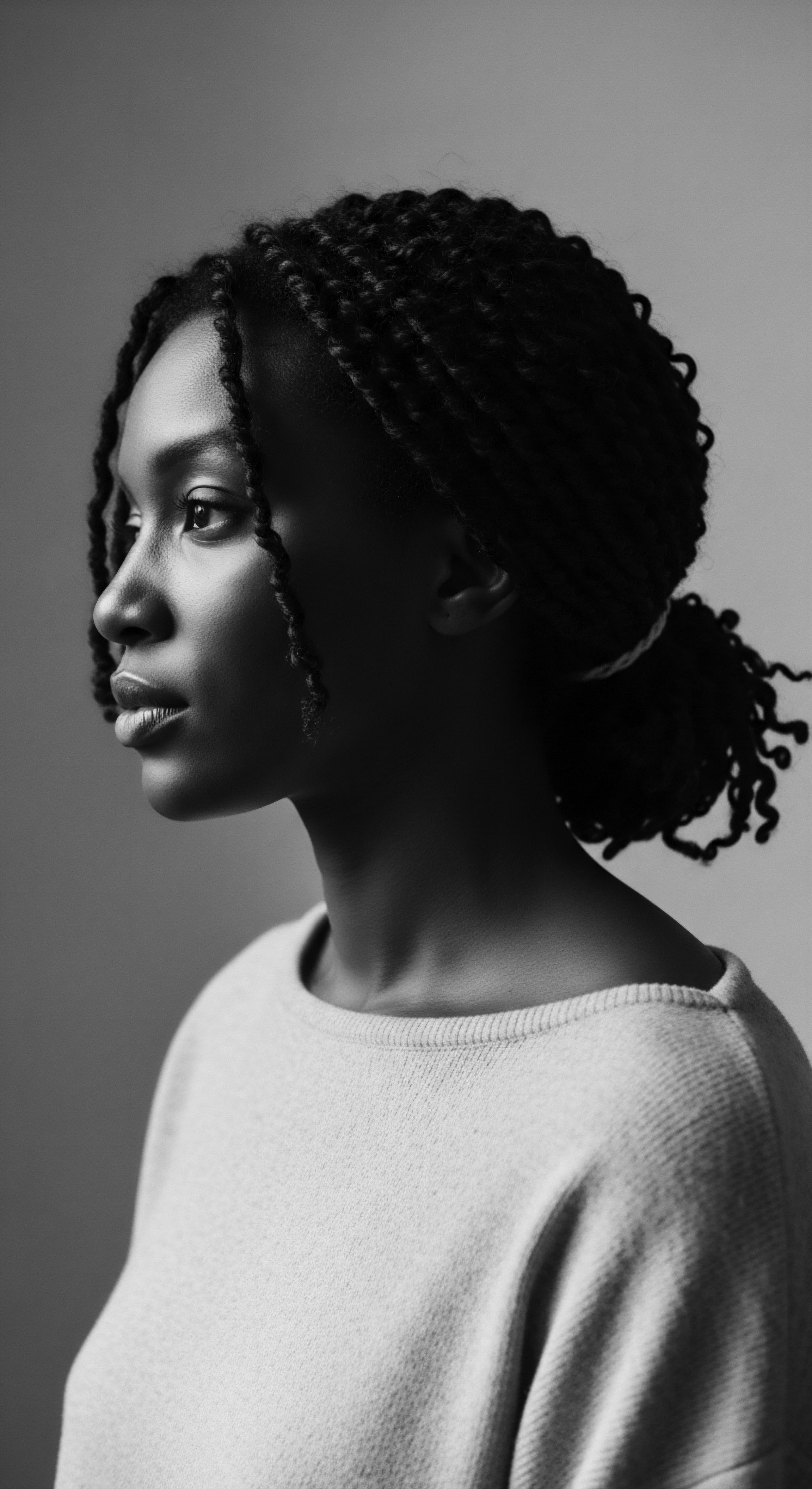
Roots
There exists a subtle current, an ancient rhythm, woven through the very fiber of textured hair. It is a cadence that speaks of resilience, of beauty cultivated across generations, and of practices rooted in the earth itself. Today, as we contemplate whether the venerable traditions of henna truly serve our diverse coils and kinks, we embark upon a deeper understanding, a mindful expedition into hair’s elemental biology and its place within human heritage.
Long before commercial dyes graced our shelves, the Lawsonia inermis plant, known as henna, offered its vibrant pigments and conditioning properties to numerous cultures. Its leaves, when crushed and prepared, yield lawsone, a compound that binds with the keratin protein of hair, imparting a reddish-orange hue and a palpable strength. This botanical interaction, a quiet dance between plant and protein, has been known and utilized for millennia, not merely for cosmetic alteration but for its protective and restorative qualities.

Ancestral Hair’s Structure
To truly appreciate henna’s historical relationship with textured hair, we must first recognize the unique architecture of these strands. Textured hair, whether tightly coiled, loosely curled, or beautifully wavy, possesses an elliptical or flat cross-section, a characteristic that influences how it grows, how it retains moisture, and how it responds to external applications. The cuticle layers, those delicate, overlapping scales that shield the hair’s inner core, tend to be more open in highly textured hair, making it prone to moisture loss yet also more receptive to absorption – a duality that traditional practices often harnessed with great wisdom.
The journey of a strand, from its follicular anchor to its visible length, is governed by cycles of growth, rest, and shedding. Ancestral care systems, passed down through oral tradition and lived experience, often moved in concert with these natural rhythms, recognizing the hair as a living extension of self and spirit. Henna, within these contexts, was not a fleeting trend but a foundational element of care, intended to bolster the hair’s natural defenses and enhance its innate luster.
The journey into henna’s efficacy for textured hair requires a recognition of the strand’s unique biological story, a tale deeply tied to ancient wisdom and continuous care.

Early Cultural Touches
The earliest records of henna’s application extend back through history, revealing its widespread presence across North Africa, West Africa, and parts of the Horn of Africa. These regions, rich in cultural diversity, cultivated the henna plant and integrated its use into daily routines and significant ceremonies alike. Its use was not limited to skin ornamentation; hair care formed a central pillar of its application. For example, in Ancient Egypt, henna adorned the nails and hair of pharaohs, serving a purpose that transcended mere aesthetics, a testament to its perceived sacredness and protective attributes (BLAM UK CIC, 2025).
The nomenclature surrounding henna across these lands further illustrates its cultural adoption. Known as ‘anella’ in North Africa, ‘lalle’ in West Africa, or ‘diabi’ in Mali, these terms speak to localized interpretations and methods of use, each name carrying the weight of a community’s particular experience with the plant. The application methods varied, from direct paste application to the intricate use of resist techniques that left bold, geometric patterns on the skin, and by extension, often informed hair practices.
- Lawsone ❉ The primary pigment molecule within henna leaves, responsible for the reddish-orange stain and its binding affinity for keratin.
- Hair Porosity ❉ The capacity of hair to absorb and hold moisture, often higher in textured hair, making it particularly receptive to natural conditioners.
- Cuticle Layers ❉ The outermost protective sheath of the hair strand, comprising overlapping scales, which can be more raised in textured hair.

Ritual
The practice of applying henna to textured hair, far from being a simple cosmetic act, has historically been a ritual, a tender thread connecting individuals to their lineage and community. These are not isolated instances but shared moments, steeped in intention and ancestral wisdom. For many, the act of preparing the henna, mixing the fine powder with water or infusions, and then applying it to the hair, invoked a sense of continuity, a participation in a living legacy.

A Legacy of Nourishment
The benefits attributed to henna within traditional textured hair care systems extend beyond color. It was valued for its ability to condition, to strengthen, and to add a particular gloss to the hair, qualities particularly pertinent to hair types often susceptible to dryness and breakage. The plant’s natural tannins, the very compounds that give it its dyeing capabilities, also contribute to a perceived tightening of the cuticle, which can smooth the hair’s surface and improve its ability to hold moisture.
Consider the observations made in the 19th century regarding hair care across West Africa. The Scottish commander Hugh Clapperton, during his expeditions in the 1820s through the Bornu Empire and Sokoto (now in northern Nigeria), observed the widespread use of henna to dye hair, alongside its use for hands and feet (Eshkol HaKofer, 2016, referencing Clapperton, 1826, p. 122; Clapperton, 1829, pp. 121, 381).
This historical evidence shows henna’s long-standing place in the hair care routines of these communities. It was not merely about a change of shade; it contributed to the health and appearance of the hair, supporting its integrity within daily life and ceremonial contexts.
Traditional preparations often incorporated other ingredients to augment henna’s properties, creating compound remedies tailored to specific hair needs. These might include various oils, herbs, or even fermented liquids, each element chosen for its particular influence on hair or scalp health. The wisdom behind these combinations stemmed from generations of observation and experimentation, a profound understanding of botanical interactions and their influence on hair physiology.
| Traditional Region West Africa (e.g. Mali) |
| Common Henna Additives Indigo, shea butter |
| Historical Hair Benefit or Use Deepening color, softening texture, protective sealant for hair. |
| Traditional Region Horn of Africa (e.g. Ethiopia) |
| Common Henna Additives Various plant extracts (e.g. Indigofera spp. ) |
| Historical Hair Benefit or Use Enhanced conditioning, anti-dandruff qualities, cleansing hair and scalp. |
| Traditional Region North Africa (e.g. Morocco) |
| Common Henna Additives Aromatic herbs, olive oil, argan oil |
| Historical Hair Benefit or Use Nourishment, scent, scalp health, and general hair vigor. |
| Traditional Region These ancestral blends underscore a sophisticated, interwoven understanding of natural compounds and their effect on hair. |

How Does Henna Interact with Textured Hair’s Porosity?
Textured hair often exhibits a natural inclination towards higher porosity, meaning its cuticle layers are more open, allowing moisture to enter and leave more readily. While this can lead to dryness, it also presents a unique opportunity for products to penetrate. Henna, with its lawsone molecules, binds to the keratin within the hair shaft, effectively laying down a protective, strengthening layer on and within the hair. This phenomenon can contribute to a reduction in porosity for some individuals, helping to seal the cuticle and diminish moisture loss, thereby fostering improved hydration and strength over time.
The subtle stiffening effect sometimes noted after a henna treatment can be especially beneficial for fine or fragile textured strands. This added rigidity, resulting from the lawsone bonding, can make the hair less prone to breakage and more resilient against manipulation. Such attributes would have been highly valued in traditional settings, where hair styles were often elaborate and communal grooming a significant social event.
Henna, in its traditional application, extended far beyond cosmetic dye; it represented a deep engagement with hair health, reinforcing strands and preserving moisture through an ancestral understanding of botanicals.

Connecting with Ancestral Methods?
When one considers adopting traditional henna practices today, the first consideration ought to be the source and purity of the henna. Ancestral communities relied on pure, finely sifted Lawsonia inermis powder. Modern markets sometimes offer “black henna” or other compounds that are not true henna and may contain harsh chemicals, which depart entirely from the ancestral practices and pose risks. The very essence of traditional benefit lies in the plant’s natural, unadulterated form.
The preparation methods too speak to a lineage of care. Rather than hurried applications, traditional practices often involved careful mixing, allowing the dye to release over time, and prolonged application periods. This slow, deliberate process honored the plant and permitted its full properties to transfer to the hair, a patience perhaps lost in our faster-paced contemporary world but worth reclaiming for its profound connection to heritage.

Relay
The enduring presence of henna in textured hair care speaks volumes about its effectiveness and cultural resonance. The knowledge of its beneficial properties, once transmitted through oral histories and demonstrations within communal settings, continues to reverberate, finding new expressions in our contemporary understanding of hair science. This continuation is a testament to the ancestral ingenuity that identified and perfected these practices across centuries.

The Science Behind Ancestral Wisdom
Modern scientific investigation increasingly validates what generations of traditional practitioners knew intuitively ❉ henna does indeed possess properties that benefit hair. The primary active component, lawsone, interacts with the hair’s keratin, a fibrous protein. This interaction forms a strong chemical bond, effectively reinforcing the hair shaft.
This process is distinct from synthetic dyes, which often penetrate the hair’s cortex by lifting the cuticle, potentially causing structural damage over repeated use. Henna’s method, by contrast, acts as a protein builder on the hair’s surface, filling in minor cuticle imperfections and smoothing the strand.
For textured hair, this translates to noticeable improvements in strength and resilience. A stronger hair strand is less prone to breakage, a common concern for coils and curls, which have natural points of fragility along their helical structure. Additionally, the smoothed cuticle can contribute to enhanced light reflection, resulting in a healthier, more lustrous appearance. This is why a rich, natural luster was often associated with hennaed hair in historical accounts.
Consider the autobiographical account of Baba of Karo, a Hausa woman from northern Nigeria (Smith, 1954). Her narrative from the early 20th century details the significant role of henna in Hausa wedding traditions, where it was not only for aesthetic adornment but also for preparations that surely contributed to the overall health and presentation of hair for such a significant life event. Such personal testimonies offer a glimpse into the integrated nature of beauty, care, and cultural identity.

Why Does Henna Offer Protective Qualities for Textured Hair?
Henna’s protective qualities stem from its unique interaction with the hair’s protein structure. When lawsone molecules bind to keratin, they create a reinforcing layer along the hair shaft. This added layer can act as a natural barrier against environmental stressors, such as sun exposure and pollution, which can otherwise compromise the integrity of hair. This protective shield is particularly helpful for textured hair, which, due to its shape and tendency for a more open cuticle, can be more susceptible to external aggressors.
Moreover, the subtle increase in hair shaft diameter that sometimes occurs with consistent henna use can contribute to a fuller appearance and a greater sense of robustness. This change, though microscopic, cumulatively strengthens the entire head of hair, making it better equipped to withstand daily styling, manipulation, and environmental challenges. It’s a botanical fortification, an ancient form of protein treatment, if you will, but without the harshness of modern chemical counterparts.
- Cuticle Sealing ❉ Henna helps to lay down the raised cuticle scales, resulting in a smoother hair surface and reduced moisture evaporation.
- Protein Binding ❉ Lawsone binds to the hair’s keratin, adding strength and reducing the likelihood of mechanical damage.
- Environmental Shield ❉ The reinforced hair shaft can offer a degree of protection against UV radiation and oxidative stress.
| Aspect Primary Function |
| Historical Heritage Perspective Cosmetic, spiritual, social marker, general hair health. |
| Modern Scientific Understanding Natural dye, conditioning, protein binding, cuticle smoothing. |
| Aspect Preparation |
| Historical Heritage Perspective Hand-grinding, plant infusions, natural acids (e.g. lime). |
| Modern Scientific Understanding Finely sifted powder, specific pH activation with acids, controlled temperatures. |
| Aspect Application |
| Historical Heritage Perspective Communal rituals, long application times (hours to overnight). |
| Modern Scientific Understanding Focused on even saturation, often with heat to improve dye uptake. |
| Aspect Perceived Benefits |
| Historical Heritage Perspective Luster, strength, protection, ritual significance, cultural identity. |
| Modern Scientific Understanding Improved tensile strength, reduced porosity, increased shine, UV protection. |
| Aspect The enduring utility of henna for textured hair lies in its consistent ability to provide both visible and structural benefits, across ages and understandings. |

Reclaiming Heritage in Modern Care
Today, the resurgence of interest in traditional practices, particularly within Black and mixed-race communities, reflects a deep longing for connection to heritage and a desire for healthier, more authentic care options. Henna, in its pure form, represents a powerful link to this past. Its slow, deliberate process invites a mindful engagement with hair care, moving away from quick fixes towards a patient, observational approach that mirrors ancestral ways.
Using henna can be an act of ancestral remembrance, a conscious choice to honor the knowledge passed down through generations. It is an acknowledgment that solutions for healthy textured hair have always existed within our own cultural frameworks. This reconnection with botanical wisdom and time-honored rituals allows for a truly holistic approach to hair wellness, one that feeds not only the strands but also the spirit, affirming the intrinsic value of heritage.
Reclaiming henna practices today offers more than cosmetic gains; it provides a tangible link to ancestral wisdom, nourishing both hair and the spirit of heritage.

Reflection
As we draw this exploration to a close, a compelling truth surfaces ❉ textured hair can indeed reap genuine benefits from traditional henna practices, today as much as in eras past. The threads of ancestral wisdom, often dismissed or forgotten in the rush of modernity, hold profound insights. Henna, as a living legacy, stands as a vibrant testament to the deep understanding our forebears held regarding natural elements and their capacity to support hair’s vitality.
The journey of a strand, from the root to its unbound helix, is a narrative of continuity, a story told through the coiled strength and luminous health of hair that has been cared for with intention. This isn’t merely about botanical compounds or chemical reactions; it is about the enduring ‘Soul of a Strand,’ recognizing hair as a powerful symbol of identity, resilience, and connection to a lineage of beauty. To choose traditional henna is, in many ways, to choose to participate in this grand, living archive of textured hair heritage, to honor its journey, and to ensure its vibrant continuation for generations yet to arrive.

References
- BLAM UK CIC. (2025). Henna Is How We Wear Our Roots.
- Clapperton, H. (1826). Journal of a Second Expedition into the Interior of Africa, from the Bight of Benin to Soccatoo. London ❉ John Murray.
- Clapperton, H. (1829). Records of Clapperton’s Last Expedition to Africa. London ❉ John Murray.
- Ethnobotany Research and Applications. (2025). Plants used for hair and skin health care by local communities of Afar, Northeastern Ethiopia.
- Eshkol HaKofer. (2016). Lalle, Anella, and Fudden ❉ Henna in West Africa.
- ResearchGate. (2024). Ethnobotanical Survey of Medicinal Plants used in the Treatment and Care of Hair in Karia ba Mohamed (Northern Morocco).
- Smith, M. (1954). Baba of Karo ❉ A Woman of the Muslim Hausa. New Haven ❉ Yale University Press.
